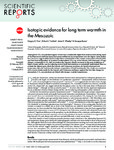Isotopic evidence for long term warmth in the Mesozoic.
| dc.contributor.author | Watanabe, Sayaka | |
| dc.contributor.author | Twitchett, RJ | |
| dc.contributor.author | Wheeley, JR | |
| dc.contributor.author | Buono, G | |
| dc.date.accessioned | 2017-03-03T13:08:01Z | |
| dc.date.available | 2017-03-03T13:08:01Z | |
| dc.date.issued | 2013-03-13 | |
| dc.identifier.issn | 2045-2322 | |
| dc.identifier.issn | 2045-2322 | |
| dc.identifier.other | 1438 | |
| dc.identifier.uri | http://hdl.handle.net/10026.1/8582 | |
| dc.description | PMCID: PMC3595697 | |
| dc.description.abstract |
Atmospheric CO2 concentrations appear to have been considerably higher than modern levels during much of the Phanerozoic and it has hence been proposed that surface temperatures were also higher. Some studies have, however, suggested that Earth's temperature (estimated from the isotopic composition of fossil shells) may have been independent of variations in atmospheric CO2 (e.g. in the Jurassic and Cretaceous). If large changes in atmospheric CO2 did not produce the expected climate responses in the past, predictions of future climate and the case for reducing current fossil-fuel emissions are potentially undermined. Here we evaluate the dataset upon which the Jurassic and Cretaceous assertions are based and present new temperature data, derived from the isotopic composition of fossil brachiopods. Our results are consistent with a warm climate mode for the Jurassic and Cretaceous and hence support the view that changes in atmospheric CO2 concentrations are linked with changes in global temperatures. | |
| dc.format.extent | 1438- | |
| dc.format.medium | ||
| dc.language | eng | |
| dc.language.iso | eng | |
| dc.publisher | Springer Science and Business Media LLC | |
| dc.subject | 0403 Geology | |
| dc.subject | 0402 Geochemistry | |
| dc.title | Isotopic evidence for long term warmth in the Mesozoic. | |
| dc.type | journal-article | |
| dc.type | Article | |
| plymouth.author-url | http://www.ncbi.nlm.nih.gov/pubmed/23486483 | |
| plymouth.issue | 1 | |
| plymouth.volume | 3 | |
| plymouth.publication-status | Published online | |
| plymouth.journal | Sci Rep | |
| dc.identifier.doi | 10.1038/srep01438 | |
| plymouth.organisational-group | /Plymouth | |
| plymouth.organisational-group | /Plymouth/Faculty of Science and Engineering | |
| plymouth.organisational-group | /Plymouth/Faculty of Science and Engineering/School of Geography, Earth and Environmental Sciences | |
| plymouth.organisational-group | /Plymouth/REF 2021 Researchers by UoA | |
| plymouth.organisational-group | /Plymouth/REF 2021 Researchers by UoA/UoA07 Earth Systems and Environmental Sciences | |
| plymouth.organisational-group | /Plymouth/Research Groups | |
| plymouth.organisational-group | /Plymouth/Research Groups/Marine Institute | |
| plymouth.organisational-group | /Plymouth/Users by role | |
| plymouth.organisational-group | /Plymouth/Users by role/Academics | |
| plymouth.organisational-group | /Plymouth/Users by role/Researchers in ResearchFish submission | |
| dc.publisher.place | England | |
| dcterms.dateAccepted | 2013-02-22 | |
| dc.identifier.eissn | 2045-2322 | |
| dc.rights.embargoperiod | Not known | |
| rioxxterms.funder | Natural Environment Research Council | |
| rioxxterms.identifier.project | Global warming and the Late Permian mass extinction event | |
| rioxxterms.versionofrecord | 10.1038/srep01438 | |
| rioxxterms.licenseref.uri | http://www.rioxx.net/licenses/all-rights-reserved | |
| rioxxterms.type | Journal Article/Review | |
| plymouth.funder | Global warming and the Late Permian mass extinction event::Natural Environment Research Council |


